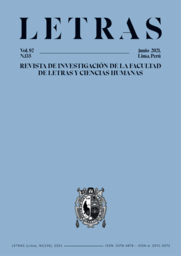Kant: The theological sublime
Abstract
It suggests the reception of the Kantian sublime as an unexpectedly religious sentiment, in other words, as a theological aesthetics. In the face of the third Critique, and with the precision of a watchmaker, the old Kant seems to balance the new cosmological, religious and metaphysical conditions confronting baroque man with the properly theological need not to exclude God from his philosophical project. In this way, Kantian aesthetics is revealed as the source of the religious, precisely, from the practical contact of the subject with the idea of divinity. In this region, the thinking subject finds an indeterminate beyond in which he is ableto touch, or, if you will, to feel the omnipotence and immensity of God. Through the propaedeutic work of the Analytic of the Sublime, the Critique of Judgment would complete the theological path traced in the second Critique by pure practical reason. Surreptitiously, the theological sublime would expose, on the one hand, Kant’s insistence on not renouncing his ironclad puritanism, and, on the other, his decision not to give in to either the intellectual despair or the metaphysical terror that the expulsion of God entails from the realm of reason.Downloads
Métricas alternativas
References
Bowie, A. (2003). Estética y subjetividad: From Kant to Nietzsche. Manchester: Manchester University Press.
Carrasco, A. (2015). American horror story: Kant, lo sublime y el terror romántico.
Kritisches Journal 2.0. Revista de Filosofía sobre Idealismo y Romanticismo, 1, 80-94.
Cassirer, E. (1948). Kant, vida y doctrina. Ciudad de México: Fondo de Cultura Económica.
Castany, B. (2012). Sublimidad y nihilismo en la cultura del Barroco. Revista de Filosofía, 2 (37), 91-110. https://doi.org/10.5209/rev_RESF.2012.v37.n2.41070
Conti, R. (2010). El sentimiento de lo sublime y el abismo de lo indeterminado en la estética de Kant. Cuadernos del Sur. Filosofía, 39, 65-84.
Darriulat, J. (2007). Introduction à la Philosophie Esthetique. http://www.jdarriulat.net/Introductionphiloesth/PhiloModerne/Kant/KantAnalSublime.html
Heidegger, M. (1929). Kant y el problema de la metafísica. Bonn: F. Cohen Editor. Kant, I. (1981). La religión dentro de los límites de la mera razón. Madrid: Alianza.
Kant, I. (1992). Crítica de la facultad de juzgar, Trad. P. Oyarzún. Caracas: Monte Ávila Editores.
Kant, I. (1998). Crítica de la razón pura, Trad. P. Ribas. Madrid: Alfaguara.
Kant, I. (2005). Crítica de la razón práctica. Ciudad de México: Fondo de Cultura Económica.
Lyotard, J. F. (1991). Leçons sur l’Analytique du sublime. París: Galilée.
Lyotard, J. F. (1998). Lo inhumano, charlas sobre el tiempo. Buenos Aires: Manantial.
Martínez Marzoa, F. (2004). Kant y la mota de polvo. Logos. Anales del Seminario de Metafísica, 37, 55-65.
Mendelssohn, M. (1999). Sobre los sentimientos. En A. Baumgarten, G. Hamann, M. Mendelssohn y J. J. Winckelmann, Belleza y verdad. Sobre la estética entre la Ilustración y el Romanticismo (pp. 125-238). Barcelona: Alba.
Murcia-Serrano, I. (2008). De Dios y lo sublime. Anales del Instituto de Investigaciones Estéticas, 93, 137-160. https://doi.org/10.22201/iie.18703062e.2008.93.2272
Oyarzún, P. (2017). Schiller: lo sublime y la revolución de la sensibilidad. Revista de Teoría del Arte, 9, 11-50.
Rogozinski, J. (2016). Al límite de lo ungeheure: sublime y monstruoso en la crítica de la facultad de juzgar. Revista Teoría del Arte, 8, 121-151.
Sandru, A. R. (2020). The Role of the Sublime in Kant’s Religion: Moral Motivation and Empirical Possibility. Kantovskij Sbornik, 39 (1), 31-57. https://doi.org/10.5922/0207-6918-2020-1-2
Trottein, S. (1998). Esthétique ou philosophie de l’art? En H. Parret (Ed.), Kants Ästhetik (pp. 660-673). Berlín, Nueva York: Walter de Gruyter.
Warnock, M. (1993). La imaginación. Ciudad de México: Fondo de Cultura Económica
Copyright (c) 2021 Letras (Lima)

This work is licensed under a Creative Commons Attribution 4.0 International License.
Este obra está bajo una licencia de Creative Commons Reconocimiento 4.0 Internacional



















